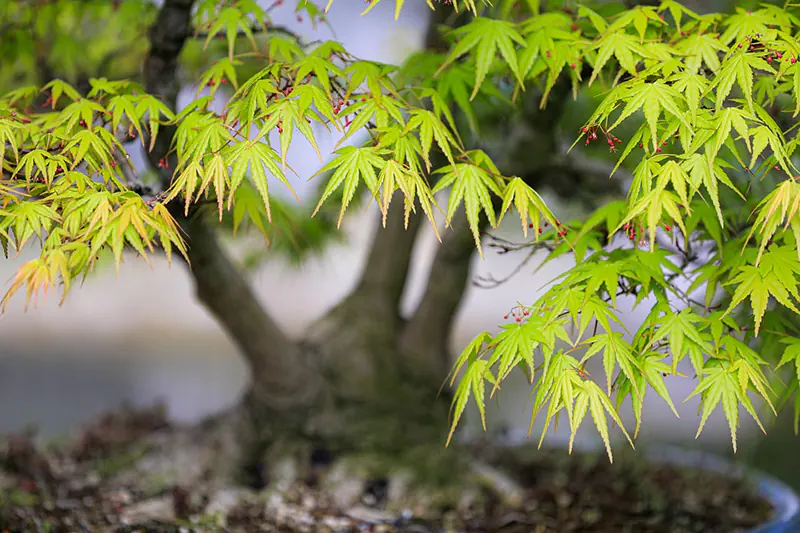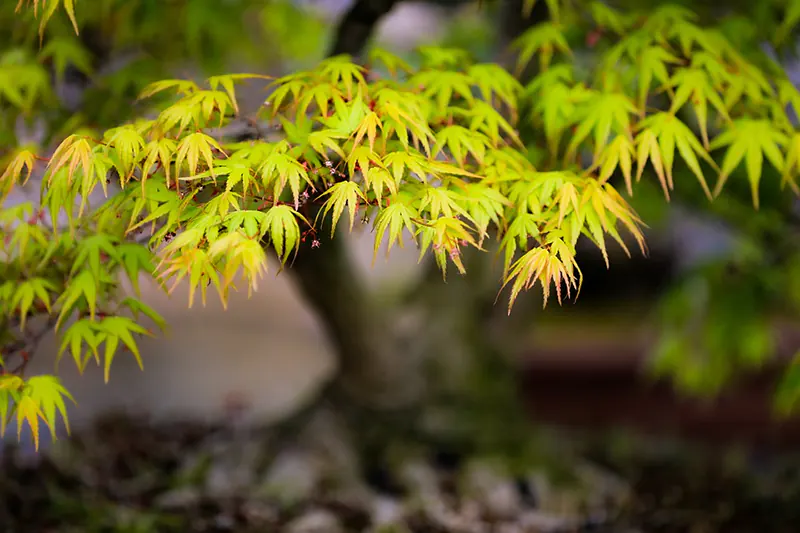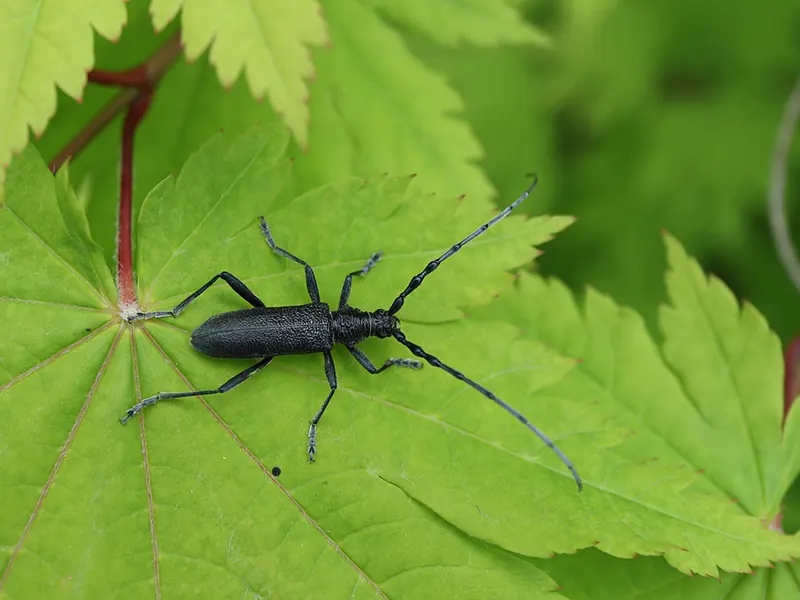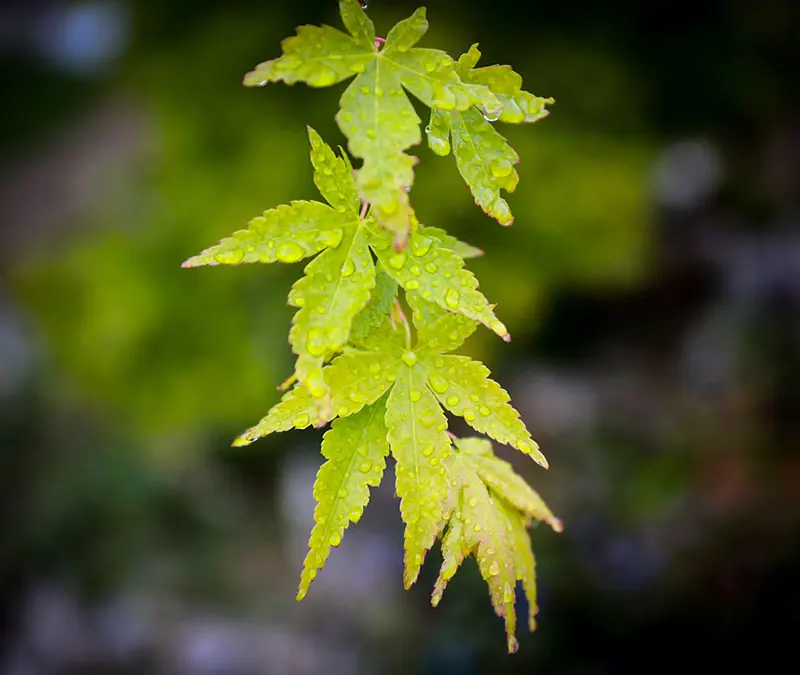Green Cascade Japanese Maple | Bonsai Care Guide
Acer palmatum var. dissectum
The green cascade Japanese maple is a wonderful tree to start growing. The tree’s leaf structure is lace-like and offers an interesting texture to look at. This small-mounded tree has a weeping habit responsible for most of its beauty.
Throughout the article, we’ll explain how you can best care for this tree and ensure it stays beautiful all through the year. We’ll also explain which propagation methods are best so you can grow new trees with ease. Whether you keep it indoors or outdoors, the green cascade Japanese maple is one of the prettiest bonsai trees to grow.
Here’s what you’ll find in our Green Cascade Japanese Maple bonsai species guide:
Here’s what you’ll find in our Green Cascade Japanese Maple bonsai species guide:
01
02
03
04
05
Quick Green Cascade Japanese Maple Bonsai Care Sheet
If you want a quick reference or overview of the information, the table below is a handy cheat sheet for caring for your green cascade Japanese maple bonsai.
Recommended soil | A soil that drains well, preferably mixed with small stones to help it quickly drain water. |
Watering | Touch soil to check for dryness as the tree may require more than one watering per day. |
Potting season | Every two years regardless of its age. |
Shaping and pruning season | Trim all through the year, larger branches only in autumn. |
Light | Requires plenty of sunlight each day but will need to be placed in indirect light when temperatures rise. |
Fertilizing | Solid organic fertilizers. |
Propagation methods | Seeds and cuttings; use air layering in summer. |
Pests and diseases | Verticillium wilt and aphids. |

How to Care for a Green Cascade Japanese Maple Bonsai
Here we’ll cover how you can care for your green cascade Japanese maple bonsai without damaging it. Following these steps will help you grow a healthy and thriving tree, whether you’re an experienced green thumb or a newcomer to the world of bonsai.
Best Soil
The best soil you can use for any Japanese maple is an akadama mix with pumice and lava rocks. The small stones help retain moisture and prevent soil erosion. However, if you’re unable to get this soil, there’s a suitable alternative.
Regular bonsai soil with a good amount of drainage will still keep the tree healthy and thriving. If you have access to the small stones, lightly mixing those in will aid the soil.
Watering
Your green cascade bonsai will require watering at least once a day during any season. Often, during warmer weather, you’ll need to hydrate your tree more frequently. This schedule may be as simple as once in the morning and once in the late afternoon once the soil dries.
When checking if the soil is dry, press your fingers down into the soil. If there’s any trace of moisture, the tree isn’t ready to be watered again. Water the tree again once you no longer feel any wetness in the soil.
Repotting
The green cascade Japanese maple’s roots are quick-growing. As such, you’ll need to prune the roots down and repot the tree at least every two years. Regardless of the tree’s age, this process will repeat as its root growth can become problematic if left unchecked.
Trimming and keeping this tree’s roots healthy is essential as it can quickly outgrow its pot, resulting in various issues.
Shaping And Pruning
Shaping and pruning can be done throughout most of the year, and if your tree is healthy and strong, throughout the whole year. The leaves, twigs, and shoots will survive without sapping away too much of your tree’s strength when trimmed during any season.
However, should you want to cut them, the larger branches need to be taken off during autumn to have the least effect on your tree’s health. While trimming these stronger branches, use a cut paste afterwards to prevent infections. This step is essential as the species is prone to fungal infections.
Location And Sunlight
Outdoors is the best location for the green cascade maple as it offers a sunny and aired area. If you can’t place the tree in direct sunlight, it will survive in indirect light. This placement option may be a better solution during the summer as the afternoon sun is particularly harsh on your tree during this season.
Fertilizing
When picking a fertilizer, you need to watch for specific criteria. The option you pick needs to have a low nitrogen level, and high nitrogen content will cause the leaves to grow quickly and look oversized. Additionally, a solid organic fertilizer is the best pick as it’s slow to release.
However, if you’re looking for a stronger fertilizer and your tree can handle the extra nutrients, there is a second option. Mix in a liquid fertilizer once every week to add more nutrients to your bonsai.
Propagation Methods
Cuttings and seeds are the easiest propagation methods for your green cascade maple. Additionally, air layering is another viable method. The propagation should be attempted during the summer, giving the tree enough time to grow before winter.
Pests And Diseases
There are two main threats to your green cascade Japanese maple bonsai. Aphids and Verticillium wilt can quickly harm or even kill your tree. Aphids are easily replaced by frequently misting your tree and using a general insecticide if the tree is infested with these pests.
Verticillium wilt is harder to control as it has no cure and can kill your bonsai tree. The infection is easily spread and requires you to isolate your bonsai to prevent it from affecting other plants. If your tree is infected, cut away the infected parts, clean the tree thoroughly, and ensure it receives plenty of nutrients. These methods will help your tree survive.

Considerations for Growing an Indoor Green Cascade Japanese Maple
While many bonsai, such as the green cascade, grow well outdoors, they’re not impossible to take indoors. However, there’s a major consideration when moving this tree inside. Here’s everything you need to know to place the green cascade indoors without harming its growth.
Placement
The green cascade requires an airy and well-lit placement. A sun-facing window is your best choice when picking the spot to place this bonsai. Opening the window during summer is advised. However, to protect the tree against the cold, you’ll want to close the window during winter.
Common Issues When Caring For a Green Cascade Japanese Maple Bonsai
While growing your green cascade Japanese maple bonsai, you’re sure to encounter various issues. However, one issue will occur more commonly than others: the watering frequency. Here’s how you can ensure you don’t over or under-water your tree.
Watering
The green cascade is an extremely thirsty tree and may require you to water it more than once a day. However, this high watering frequency can lead you to over-water the tree if you aren’t paying attention. To avoid harming your tree, touch the soil and feel around for any hunt of moisture. If the soil is still wet, you don’t need to water your bonsai yet.
FAQs about Green Cascade Japanese Maple Bonsai
Here are five of the most commonly asked questions about the green cascade and the rest of the Japanese maple species. We’ll explain how to care for your tree and whether it needs a full day of sun or not. We also explain if any tree can be grown as a bonsai.
To properly care for your green cascade Japanese maple, you must keep it in a well-lit spot. Additionally, you’ll need to water the tree at least once a day or more and repot the tree every two years. Careful pruning and trimming of the leaves and shoots are required.
You can turn almost any tree into a bonsai, especially the large variety of maple trees. These trees often make great starters for beginners as they’re hardy and can be cared for with little skill. The main aspects to remember with this tree are watering it daily and ensuring it gets enough sunlight.
A Japanese maple such as the green cascade doesn’t require a full day of direct sunlight. However, as much sunlight as you can give it is best. During summer, the tree should be sheltered from direct afternoon sunlight as this can damage the leaves and slow its growth.
Japanese maples live for 50 to 80 years if correctly cared for and nurtured. This process requires you to ensure the tree gets water daily, has enough sunlight, and receives added nutrients through a solid organic fertilizer.







